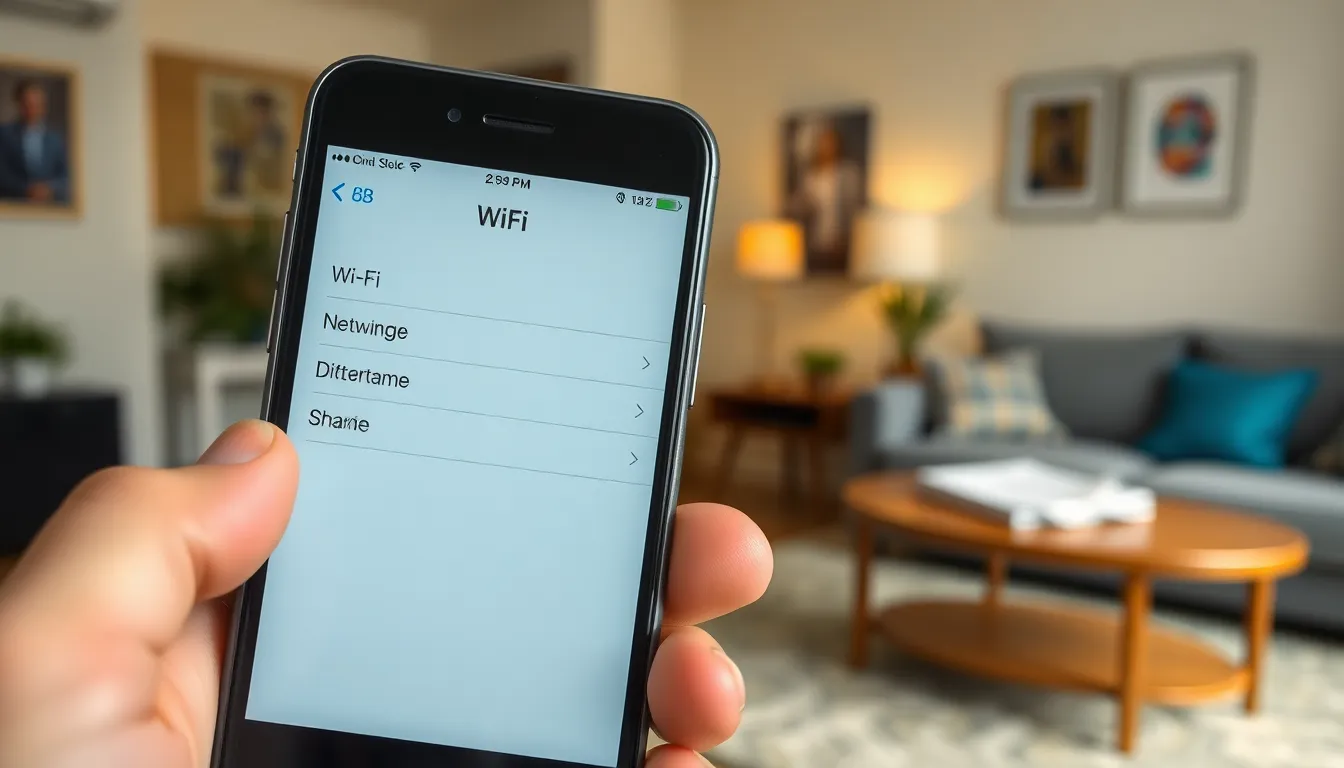In a world where streaming cat videos and gaming marathons reign supreme, knowing whether your iPhone is connected to 2.4GHz or 5GHz Wi-Fi can make all the difference. Picture this: you’re trying to binge-watch the latest series, but your connection feels slower than a dial-up modem. Frustrating, right? Understanding your Wi-Fi frequency isn’t just techy jargon—it’s the key to unlocking faster speeds and smoother connections.
Table of Contents
ToggleUnderstanding WiFi Frequencies
Knowing the difference between Wi-Fi frequencies plays a crucial role in optimizing internet use on an iPhone. Two main bands exist: 2.4 GHz and 5 GHz, each offering distinct advantages.
What Are 2.4 GHz and 5 GHz Bands?
2.4 GHz bands cater to longer-range connections. They penetrate walls and obstacles effectively, making them suitable for larger spaces. Multiple devices can connect simultaneously on this frequency. Often, many household devices, like microwaves and Bluetooth gadgets, operate within this band, leading to potential interference. On the other hand, 5 GHz bands focus on higher speeds. They deliver faster download and upload rates, ideal for activities like streaming and gaming. This frequency has a shorter range, making it better suited for smaller areas with less obstruction.
Key Differences Between 2.4 GHz and 5 GHz
Key differences influence user experience significantly. 2.4 GHz provides wider coverage, while 5 GHz supports higher speeds. Users may notice slower performance in crowded environments on 2.4 GHz. Conversely, 5 GHz can handle more data without slowing down, enhancing performance during multiple device use. Interference occurs more frequently in the 2.4 GHz band due to various household appliances. In contrast, the 5 GHz band typically faces less interference, resulting in a more stable connection. Understanding these differences helps iPhone users select the best Wi-Fi frequency according to their specific needs.
How to Check Your WiFi Band on iPhone

Checking the WiFi band on your iPhone is straightforward. Users can follow a few simple steps to determine if they’re connected to the 2.4 GHz or 5 GHz band.
Step-by-Step Guide to Find WiFi Frequency
- Open the Settings app on your iPhone.
- Tap on Wi-Fi to see the list of available networks.
- Locate your connected network. Next to the network name, a small icon may indicate the WiFi band.
- If the network name includes a suffix like “5G” or “5GHz,” it’s connected to the 5 GHz band.
- Alternatively, use a network analysis app from the App Store. These apps often provide detailed information about the currently connected band.
Following these steps clarifies the WiFi band in use, helping users optimize their connectivity for better performance.
Advantages and Disadvantages of Each Band
Understanding the advantages and disadvantages of the 2.4 GHz and 5 GHz Wi-Fi bands helps users make informed connectivity choices. Each band serves distinct needs, impacting user experience.
Benefits of 2.4 GHz WiFi
Strong signal penetration characterizes the 2.4 GHz band. It performs well in larger spaces, ensuring a stable connection even through walls and obstacles. Many devices, including older models, support this frequency, ensuring broad compatibility. Interference from household items, such as microwaves and cordless phones, poses a challenge, yet the band still caters to basic internet tasks, like browsing and emailing. Users often find this band sufficient for general use, especially in homes with multiple devices.
Benefits of 5 GHz WiFi
High-speed capabilities define the 5 GHz band. With less congestion available, users experience faster upload and download speeds, making it ideal for activities like gaming and streaming. Lower latency enhances performance, supporting smoother online interactions. Its shorter range may limit coverage, but in closer proximity to the router, 5 GHz excels. This band provides excellent performance in environments with heavy internet use, ensuring consistent and reliable connectivity.
Troubleshooting Common Connection Issues
Connection issues can disrupt the iPhone experience. Identifying these problems promptly helps maintain a reliable internet connection.
Identifying Band Issues on Your iPhone
First, check the Wi-Fi settings to identify the connected band. Look for network names with “5G” or “5GHz” to confirm a 5 GHz connection. Review the Wi-Fi signal strength listed alongside the network name. Weak signals indicate potential interference or range issues, often caused by physical barriers or electronic devices nearby. If experiencing slow speeds, it could signify that the iPhone connects to the 2.4 GHz band, which is slower yet offers better range. Recognizing these signs allows users to take appropriate actions for improved connectivity.
Solutions for Band Connectivity Problems
Switching to the less congested 5 GHz band can significantly enhance the browsing experience. Restart the router to resolve minor connectivity issues. Position the router closer for stronger signals; this positioning helps overcome physical obstacles that weaken transmission. If issues persist, consider updating the router’s firmware. Using network analysis apps assists users in monitoring which band offers better performance in their environment. These solutions enable a smoother and faster internet experience for iPhone users.
Understanding whether an iPhone is connected to the 2.4 GHz or 5 GHz Wi-Fi band is crucial for optimizing internet performance. This knowledge empowers users to choose the best connection for their needs whether it’s for streaming high-definition content or engaging in online gaming.
By following simple steps to check the Wi-Fi band and utilizing network analysis apps, users can enhance their connectivity experience. With the right information and tools at hand, achieving faster speeds and more reliable connections becomes attainable. Making informed decisions about Wi-Fi usage can lead to a significantly improved online experience for everyone.




